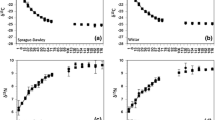Summary
Consequences of size-dependent metabolic rate on the turnover of trace substances in animals are investigated. At steady state, the biological half-life, body burden, and whole body concentration of a trace substance are shown to be proportional to body weight raised to (1-b), 1, and 0, respectively, where b is the exponent relating body weight to standard metabolic rate. The condition is that the trace substance is turned over in proportion to the standard metabolic rate; the derived equations can accordingly be used to test whether a given substance is feasible as a tracer of energy flow in ecologic systems.
Similar content being viewed by others
References
Bergner, P.E.E.: The concepts of mass, volume and concentration. In: Compartments, pools and spaces in medical physiology, pp. 21–37. USAEC (1967)
Boyden, C.R.: Trace element content and body size in molluscs. Nature 251, 311–314 (1974)
Brody, S.A.: Bioenergetics and growth. New York: Reinhold 1945
Eberhardt, L.L.: Relationship of cesium-137 halflife in humans to body weight. Health Phys. 13, 88–90 (1967)
Eberhardt, L.L.: Similarity, allometry and food chains. J. theor. Biol. 24, 43–55 (1969)
Fagerström, T., Åsell, B.: On realism and generality of bio-accumulation models. Towards a general methodology. Proc. Int. Conf. Transp. Persist. Chem. Aquat. Ecosystems, pp. IV11xxx-IV16xxx. Ottawa: Ottawa University Press 1974
Fagerström T., Åsell, B., Jernelöv, A.: Model for accumulation of methyl mercury in northern pike Esox lucius. Oikos 25, 14–20 (1974)
Fagerström, T., Kurtén, R., Åsell, B.: Statistical parameters as criteria in model evaluation: kinetics of mercury accumulation in pike Esox lucius. Oikos 26, 109–116 (1975)
Fowler, S.W., Small, L.F., Dean, J.M.: Metabolism of zinc-65 in Euphausiids. Symposium on Radioecology 670503, pp. 399–411, USAEC (1967)
Fujita, M., Iwamoto, J., Kondo, M.: Comparative metabolism of cesium and potassium in mammals —interspecies correlation between body weight and equilibrium level. Health Phys. 12, 1237–1247 (1966)
Hemmingsen, A.M.: The relation of standard (basal) energy metabolism to total fresh weight of living organisms. Rep. Steno Hosp., Copenh. 4, 7–58 (1950)
Kerr, S.R., Vass, W.P.: Pesticide residues in aquatic invertebrates. In: Environmental pollution by pesticides, pp. 134–180. New York: Plenum 1973
Kimura, K., Ichikawa, R.: Uptake of ruthernium-106 by Short-necked clam. Bull. Jap. Soc. Sci. Fish. 36, 653–660 (1970)
Kleiber, M.: The fire of life. New York: Wiley 1961
Kleiber, M.: Metabolic turnover rate: a physiological meaning of the metabolic rate per unit body weight. J. theor. Biol. 53, 199–204 (1975)
Morgan, F.: The uptake of radioactivity by fish and shellfish. I. 134Caesium by whole animals. J. mar. biol. Ass. U.K. 44, 259–271 (1964)
Norstrom, R.J., McKinnon, A.E., de Freitas, A.S.W.: A bioenergetics-based model for pollutant accumulation by fish. Simulation of PCB and methylmercury residue levels in Ottawa River Yellow perch. J. Fish. Res. Board Can. 33, 248–267 (1976)
Olson, K.R., Bergman, H.L., Fromm, P.O.: Uptake of methyl mercuric chloride and mercuric chloride by trout: a study of uptake pathways into the whole animal and uptake by erythrocytes in vitro. J. Fish. Res. Board Can. 30, 1293–1299 (1973)
Reichle, D.E.: Relation of body size to food intake, oxygen consumption, and trace element metabolism in forest floor arthropods. Ecology 49, 538–542 (1968)
Reichle, D.E., Dunaway, P.B., Nelson, D.J.: Turnover and concentration of radionuclides in food chains. Nucl. Safety 11, 43–55 (1970)
Reichle, D.E., Van Hook, Jr., R.I.: Radionuclide dynamics in insect food chains. Manitoba Entomologist 4, 22–32 (1970)
Renfro, W.C., Fowler, S.W., Heyraud, M., La Rosa, J.: Relative importance of food and water in longterm zinc-65 accumulation by marine biota. J. Fish. Res. Board Can. 32, 1339–1345 (1975)
Stahl, R.S.: Similarity and dimensional methods in biology. Science 137, 205–212 (1962)
Stahl, R.S.: Organ weights in primates and other mammals. Science 150, 1039–1042 (1965)
Vanderploeg, H.A.: Rate of zinc uptake by Dover sole in the northeast Pacific Ocean: preliminary model and analysis. Radionuclides in ecosystems, Vol I, CONF-710501, pp. 840–848, USAEC (1971)
Author information
Authors and Affiliations
Rights and permissions
About this article
Cite this article
Fagerström, T. Body weight, metabolic rate, and trace substance turnover in animals. Oecologia 29, 99–104 (1977). https://doi.org/10.1007/BF00345790
Received:
Issue Date:
DOI: https://doi.org/10.1007/BF00345790




